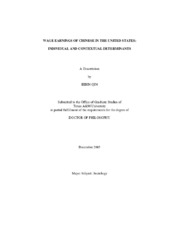| dc.description.abstract | The objective of this dissertation is to identify both individual and contextual
characteristics that may affect the wage earnings of Chinese in the U.S. labor market.
The major individual characteristics include education, labor experience, and English
ability; the contextual factors include percent of Chinese Americans, percent of Asian
Americans, percent of nonwhites, percent of Chinese-owned businesses, occupational
and residential segregation between Chinese and whites, and unemployment rate.
Using the combined data of one percent and five percent 2000 Public Use
Microdata Samples for 70 metropolitan areas, hierarchical linear models (HLM) were
run for three groups of Chinese: native-born, foreign-born U.S. citizens, and foreignborn
non-U.S. citizens. The results show that the returns to education are highest for the
native-borns but lowest for the non-U.S. citizens. A command of good English benefits
recent immigrants more than the native-borns. Labor experience tends to bring positive
gains to both native-born and foreign-born U.S. citizens but shows no effects on earnings of foreign-born non-U.S. citizens. The results support both the human capital and
assimilation perspectives.
The HLM results indicate that occupational segregation from majority whites
tends to impose a strong and negative effect on the earnings of native-born Chinese; a
higher percentage of Chinese-owned businesses tends to increase the earnings of only
foreign-born U.S. citizens; unemployment rate is likely to depress the wage earnings of
the foreign-borns but not the native-borns. This suggests that Chinese workers with a
different immigration history face the labor market differently. Residential segregation,
percent of Chinese Americans, percent of Asian Americans, and percent of nonwhites,
do not show any direct effects.
Occupational segregation, the percent of Chinese-owned businesses, and the
representation of the Chinese population are found to impact earnings indirectly through
the individual characteristics. All these findings suggest that contextual factors do not
necessarily impose direct effects on wage earnings; however, they may transfer their
effects onto earnings via individual characteristics.
This study represents an attempt to bring new insights into earnings attainment
models and an addition to the meager body of knowledge concerning both individual and
contextual factors that may affect the earnings process of a minority group in the United
States. The strengths of using the HLM techniques, the limitations of the study, as well
as issues for future study, were also discussed. | en |


